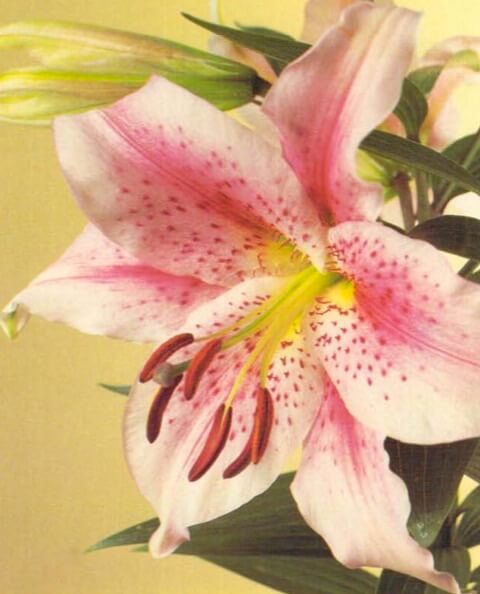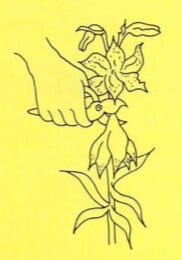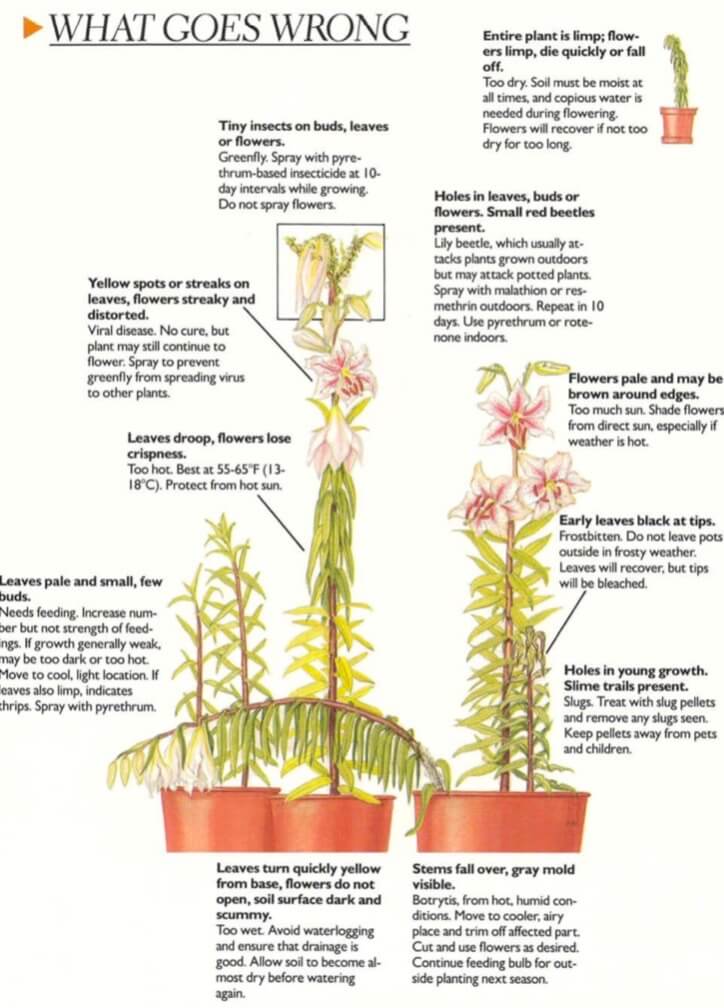[Ebook Việt Hoá] The Instant Guide to Healthy Houseplants (Hướng dẫn tức thời để chăm cây trong nhà khoẻ mạnh), Chi Lilium - Chi Loa Kèn
[Ebook Việt Hoá] The Instant Guide to Healthy Houseplants: Lilium bakerianum (Lily)
- Nguồn: [Ebook Việt Hoá] The Instant Guide to Healthy Houseplants (Hướng dẫn tức thời để chăm cây trong nhà khoẻ mạnh)
- Biên tập: Dũng Cá Xinh
- Biên dịch: Team Codai.net
English
Lilies are among the most beautiful and elegant of all flowering bulbs. Although most are hardy and suitable only for growing outdoors, there are now several species of Asiatic and oriental hybrids suitable for growing indoors in pots or containers. Lilium longiflorum (Easter lily) is also a common plant in the spring of the year. Lilies can be bought in pots in bud stage and need only full light and plenty of water to bloom. They can also be grown from bulbs planted in winter in individual 4-in(10-cm) pots. Pot-grown lilies will rarely flower again; so when blooming has finished, either discard or replant outdoors. Hardy lilies such as the mid-century hybrid ‘Enchantment’ can also be grown in pots without heat for early summer flowering.

Light
Needs full light at all times. but shade flowers from hot sun.
Temperature
Does best at 55-65°F (13- 18°C) but can tolerate higher or lower temperatures. Will not survive frost or extreme heat.
Water
Soil must be moist at all times. Water twice a week after pot- ting. increasing frequency as growth increases. Water copiously (daily if necessary) while in bloom.
Humidity
Cool, well-ventilated location is preferred. If weather is very hot. spray around flowers in evening.
Feeding
Use liquid houseplant food at manufacturer’s recommended strength every 10 days if in loam-based soil. every 5 days if in soilless media
Soil
Use either loam-based soils or soilless media.
After flowering
Flowers bloom in succession. Remove dead flower heads to encourage stronger blooms. Pot-grown plants generally do not flower again.

What Goes Wrong

- Entire plant is limp; flowers limp, die quickly or fall off: Too dry. Soil must be moist at all times. and copious water is needed during flowering. Flowers will recover if not too dry for too long.
- Tiny insects on buds, leaves or flowers: Greenfly. Spray with pyre- thrum-based insecticide at 10- day intervals while growing. Do not spray flowers.
- Holes in leaves, buds or flowers. Small red beetles present: Lily beetle. which usually attacks plants grown outdoors but may attack potted plants. Spray with malathion or resmethrin outdoors. Repeat in 10 days. Use pyrethrum or rote-none indoors.
- Leaves pale and small, few buds: Needs feeding. Increase number but not strength of feedings. If growth generally weak. may be too dark or too hot. Move to cool. light location. If leaves also limp. indicates thrips. Spray with pyrethrum.
- Holes in young growth. Slime trails present: Slugs. Treat with slug pellets and remove any slugs seen. Keep pellets away from pets and children.
- Stems fall over, gray mold visible: Botrytis. from hot. humid conditions. Move to cooler. airy place and trim off affected part. Cut and use flowers as desired. Continue feeding bulb for out- side planting next season.
- Leaves droop, flowers lose crispness: Too hot. Best at 55-65°F (13-18°C). Protect from hot sun.
- Flowers pale and may be brown around edges: Too much sun. Shade flowers from direct sun. especially if weather is hot.
- Leaves turn quickly yellow from base, flowers do not open, soil surface dark and scummy: Too wet. Avoid waterlogging and ensure that drainage is good. Allow soil to become almost dry before watering again.
- Yellow spots or streaks on leaves, flowers streaky and distorted: Viral diseases. No cure, but plant may still continue to flower. Spray to prevent greenfly from spreading virus to other plants.
Tiếng Việt
Hoa Ly là một trong những loài hoa đẹp và thanh lịch nhất trong số tất cả các loại củ có hoa. Mặc dù hầu hết đều cứng và chỉ thích hợp để trồng ngoài trời, nhưng hiện nay có một số loài lai châu Á và phương Đông thích hợp để trồng trong nhà trong chậu hoặc thùng chứa. Lilium longiflorum (hoa loa kèn) cũng là một loài cây thường thấy hàng năm vào mùa xuân. Hoa ly có thể được mua trong chậu ở giai đoạn nụ và chỉ cần ánh sáng đầy đủ và nhiều nước là có thể nở hoa. Chúng cũng có thể trồng từ các củ được trồng vào mùa đông trong các chậu riêng lẻ 4 inch (10 cm). Hoa Ly trong chậu sẽ hiếm khi ra hoa trở lại; vì vậy khi hoa nở xong có thể bỏ đi hoặc trồng lại ngoài trời. Những loài cứng cáp như ‘Enchantment‘ lai được trồng trong chậu không cần nhiệt để ra hoa vào đầu mùa hè.

Ánh sáng
Cần ánh sáng đầy đủ mọi lúc nhưng che nắng cho hoa.
Nhiệt độ
Phát triển tốt nhất ở 55 – 65 ° F (13 – 18 ° C) nhưng có thể chịu được nhiệt độ cao hơn hoặc thấp hơn. Sẽ chết nếu băng giá hoặc nhiệt độ quá cao.
Nước
Đất phải luôn ẩm. Tưới nước hai lần một tuần, tần suất tăng khi cây phát triển. Tưới nước thật nhiều (hàng ngày nếu cần) khi hoa nở.
Độ ẩm
Ưu tiên vị trí thoáng mát, thông thoáng. Nếu thời tiết rất nóng, phun xung quanh hoa vào buổi tối.
Bón phân
Sử dụng phân bón cho cây trồng trong nhà dạng lỏng theo khuyến cáo của nhà sản xuất cứ 10 ngày một lần nếu ở đất mùn và 5 ngày một lần nếu trong môi trường không có đất
Đất
Sử dụng đất mùn hoặc đất không có đất.
Sau khi ra hoa
Hoa nở nối tiếp nhau. Loại bỏ các đầu hoa đã chết để khuyến khích hoa nở nhiều hơn. Cây trồng trong chậu thường không ra hoa trở lại.

Những vấn đề có thể xảy ra

- Toàn bộ cây đều mềm nhũn; hoa mềm nhũn, chết nhanh hoặc rụng: Quá khô. Đất phải luôn ẩm và lượng nước dồi dào là cần thiết trong quá trình ra hoa. Hoa sẽ phục hồi nếu không bị khô quá lâu.
- Côn trùng nhỏ trên chồi, lá hoặc hoa: Ruồi xanh. Phun thuốc trừ sâu pyrethrum cách nhau 10 ngày khi cây đang phát triển. Không phun hoa.
- Các lỗ trên lá, chồi hoặc hoa. Bọ cánh cứng màu đỏ nhỏ hiện diện: Bọ cánh cứng thường tấn công các cây trồng ngoài trời nhưng có thể tấn công các cây trồng trong chậu. Phun malathion hoặc resmethrin ngoài trời. Lặp lại trong 10 ngày. Sử dụng pyrethrum hoặc roteno trong nhà.
- Lá nhạt và nhỏ, ít búp: Cần chăm sóc. Tăng số lượng nhưng không tăng cường độ của phân bón. Nếu tăng trưởng yếu có thể do quá tối hoặc quá nóng. Di chuyển đến vị trí sáng và mát mẻ. Nếu lá cũng mềm nhũn chứng tỏ có bọ trĩ. Xịt bằng pyrethrum.
- Các lỗ trong quá trình phát triển non. Xuất hiện vết nhờn: Sên. Xử lý bằng viên diệt sên và loại bỏ những con sên nhìn thấy. Để viên diệt sên tránh xa vật nuôi và trẻ em.
- Thân cây bị đổ, mốc xám: Nấm mốc do nóng hoặc do ẩm ướt. Di chuyển đến nơi thoáng mát và cắt bỏ phần bị ảnh hưởng. Cắt và sử dụng hoa như mong muốn. Tiếp tục cho củ để trồng bên ngoài vào mùa sau.
- Lá rũ xuống, hoa mất độ giòn: Quá nóng. Tốt nhất ở 55 – 65 ° F (13 – 18 ° C). Bảo vệ khỏi nắng nóng.
- Hoa nhạt màu và có màu nâu xung quanh mép: Quá nhiều nắng. Che nắng cho hoa. Đặc biệt là nếu thời tiết nóng.
- Lá nhanh chóng chuyển sang màu vàng từ gốc, hoa không nở, bề mặt đất sẫm màu và có bọt: Quá ẩm ướt. Tránh úng nước và đảm bảo thoát nước tốt. Để đất gần như khô trước khi tưới lại.
- Các đốm hoặc vệt vàng trên lá, hoa mọc thành vệt, méo mó: Bệnh do virus. Không có cách chữa trị, nhưng cây vẫn có thể tiếp tục ra hoa. Phun để ngăn chặn ruồi xanh lây lan vi rút sang các cây khác.
![[Ebook Việt Hoá] The Instant Guide to Healthy Houseplants: Lilium bakerianum (Lily) [Ebook Việt Hoá] The Instant Guide to Healthy Houseplants: Lilium bakerianum (Lily)](https://vn1.vdrive.vn/codai.net/2020/02/ebook-huong-dan-tuc-thoi-cham-cay-trong-nha-khoe-manh-66-lilium-bakerianum.jpg)


